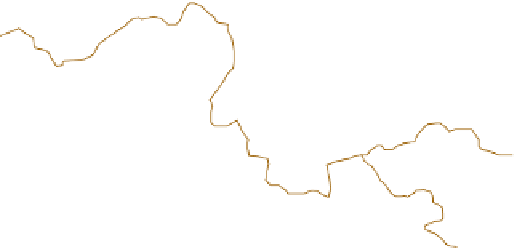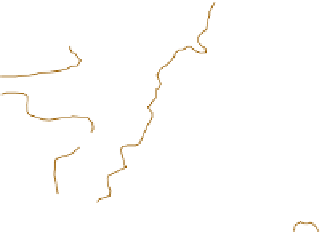Geoscience Reference
In-Depth Information
MONGOLIA
Beijing
N
Present
distribution
Approximate
prehistoric
distribution
Yellow
Sea
Yellow
Sea
CHINA
Xian
Quingling Mts.
Minshan Mts.
Wolong
Reserve
Xianging
Mts.
Qionglai
Mts.
Chonking
Liangshan
Mts.
Xun River
Bhutan
INDIA
So
ut
h
Chin
a
Se
a
South
China
Sea
SSouth
ina
China
Sea
Bangladesh
Vietnam
300
0
600 km
Hainan
H
a
i
in
a
Myanmar
Laos
H
a
n
n
0
200
400 mi
Figure 20.31 Prehistoric and current range of giant pandas in southeastern Asia.
Note the ex-
tensive decline in panda range that has occurred over time. This loss of habitat has generally coincided
with two major periods of population growth in China.
In prehistoric times, the pandas' natural range once
extended throughout the forests of southeastern China, Myan-
mar (formerly Burma), and even into India (Figure 20.31).
This area lies largely within the humid subtropical hot-summer
climate (
Cfa, Cwa
) region of southeastern Asia, which, if you
recall from Chapter 9, is dominated by monsoon atmospheric
circulation. During the 18th century the extent of panda habitat
progressively shrank because lowland subtropical forests were
cleared for agriculture and wood fuel for cooking and home
heating. This expansion of agriculture and loss of panda habitat
occurred during a major growth phase in Chinese population
from about 140 million people in 1700 to approximately 400
million in 1900 (Figure 20.25). As a result, by 1900, panda hab-
itat was confined to the Qinling Mountains in the north-central
part of their historical range and the Minshan, Xiangling, Qion-
glai, and the Liangshan Mountains in the west-central part of
their ancestral range (Figure 20.31).
During the 20th century panda habitat was further reduced
as agriculture expanded along the major river valleys within the
region. This growth of farming occurred at the same time that
Chinese population grew rapidly from about 500 million peo-
ple in 1950 to over 1.3 billion presently (Figure 20.32). Pandas
were also hunted for pelts and because it was believed that their
body parts had medicinal qualities valued in traditional Chinese
culture. Today, pandas are found only in about 20 isolated parts
of the six mountain ranges mentioned previously and live in
dense stands of bamboo that lie between about 1500 m and
3500 m (~4900 ft and 11,500 ft) above sea level. Their optimal
altitudinal range is between 2500 m and 3000 m (~8200 ft to
9800 ft) above sea level. Given their need to conserve energy,
they prefer level terrain (<15˚ slopes) within the mountains so
they can move about easily.
As population in China increased in the latter half of the 20th
century, concerns about the viability of wild panda populations
began to grow. In the early 1960s the first four panda reserves
were established by the Chinese government and hunting was
outlawed. Additional reserves were established in the 1970s,
including a permanent research station at the Wolong Nature
Reserve. In the 1980s pandas were given even more legal protec-
tion and hunters began to be prosecuted vigorously for killing
them. At about this same time, however, geographical surveys in-
dicated that the extent of panda habitat dropped from 29,500 km
2






























































































